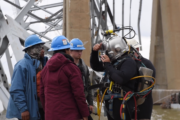If you remember back to 10th grade biology, you probably learned that all life can be traced back to the set of instructions encoded in DNA. This molecule found in every living cell contains a very precise story — the book of life. But over time, and with exposure to certain environmental factors, sometimes mistakes in the code arise; as new cells are created, sometimes the translation of the code doesn’t occur with 100 percent accuracy. These mistakes can proliferate and turn into diseases such as cancer.
But what if there were a way to simply edit out the mistakes like you would when typing an email? What if you could just put your cursor over the incorrect letter or word, hit delete, and then type in the correct letter or word? Suddenly your sentence makes sense again and the error has disappeared, almost like it never existed in the first place.
This is the basic concept behind a technology that’s been garnering a lot of interest over the past several years. Called CRISPR, which stands for Clustered Regularly Interspaced Short Palindromic Repeat, this genetic editing technology offers hope that one day doctors will be able to easily correct the errors that can crop up in our genetic code, leading to advanced cures for genetic diseases and cancer.
[See: 10 Innovations in Cancer Therapy.]
Dr. Hans-Peter Kiem, director of the stem cell and gene therapy program at the Fred Hutchinson Cancer Research Center in Seattle, says, “CRISPR technology is essentially scissors that can cut DNA in very precise locations.” Although CRISPR is not the only gene editing tool in existence, it’s more agile and “practical,” he says, than some of the other options. “It’s easier to design them and it’s a very easy scissor. Imagine you have a big set of scissors that’s very difficult to handle. Then you’ve got a very easy-to-handle, small pair of scissors that can make that cut at that same site very easily.” Naturally, if you need to make a precision cut, you’ll opt for the more precise scissors, and this is what CRISPR offers scientists, Kiem says.
It’s this precision that gives scientists hope that CRISPR technology may offer the answer to a variety of diseases that arise because of mutations in specific genes, because these mutations can effectively be cut out of the DNA code. Corrected genetic code can be inserted in its place and the cell can go on to live and reproduce normally without the genetic mutation that causes the disease.
So far, CRISPR technology has shown a lot of promise in editing embryonic DNA to eliminate genetic diseases. “There’s a scientific and medical effort in certain countries where they are using CRISPR to modify fertilized eggs in humans where there may be diseases they may want to correct,” says Dr. David Tuveson, director of the cancer center and cancer therapeutics initiative at the Cold Spring Harbor Laboratory in Cold Spring Harbor, New York. Making edits in that initial fertilized egg is relatively easy, allowing it to develop into a healthy organism free of genetic disease. “That cell would give rise to all the rest of the cells,” and if the genetic error isn’t propagated, the disease doesn’t materialize.
In terms of CRISPR being a way to fix genetic diseases like sickle cell anemia and other diseases where the cause is a change in a single base pair, theoretically, CRISPR can already “cure” those diseases with the information we have now. This is an area where Kiem is working and he believes there’s much promise that scientists will solve sickle cell anemia in the near future. The problem is that in practical terms, those genetic edits need to be made to every single cell that’s involved in the disease process. Delivering that gene editing technology to each individual cell is not something we can reliably do yet.
The picture gets even more complicated when we talk about a disease like cancer, where a genetic mutation in a single cell can give rise to the growth of a tumor which may spread to other parts of the body if left unchecked. “If it were a treatment for cancer, you’d have to deliver the CRISPR technology to all the cells to change [the genetic mutation that caused the cell to become cancerous] back to normal. Not impossible, but it’s not something you can readily do today,” Tuveson says. “The technology isn’t quite at that level yet.”
[See: What Not to Say to a Breast Cancer Patient.]
Still, work continues to develop CRISPR-based tools that may eventually help cure cancer or at least leverage what we know about the genetic causes of cancer to guide treatment decisions. Dr. Alan B. Copperman, director of the division of reproductive endocrinology and vice-chairman of the department of obstetrics, gynecology and reproductive science at the Icahn School of Medicine at Mount Sinai, says, “in the near future, we most likely will see CRISPR and other gene editing technologies revolutionize cancer therapy. One potential application involves removing some of a patient’s own immune cells ( T Cells), re-programming them using CRISPR and then infusing these cells back into the patient to fight the cancer. This personalized immunotherapy approach should help in fighting off many different types of cancers.” This method is already being used as a treatment for some cases of leukemia and lymphoma.
T cells are part of the body’s immune system, which can be modified in the lab to add a special receptor called a chimeric antigen receptor, or CAR. These modified T-cells are then infused back into the patient where the CAR T-cells go to work attacking the cancer cells. Using CAR T-cells as a treatment for solid tumors, such as occurs in breast, colon or lung cancer, is not currently practical, because it’s harder to ensure delivery of the therapy to each and every cell in the tumor. But in a liquid environment, leveraging the power of the immune system to reprogram cancer cells is becoming a reality for some patients.
“The immune system is more nonspecific,” Kiem says. With a cancer that occurs more diffusely, such as that in cancers of the blood of lymphatic system, this process works better than in solid tumors. “You can definitely alter and reprogram individual tumor cells, so that is possible. And I could envision this already now, but you’d have to hit all the cells, so there’s a delivery limitation,” or how to target every last cell in the tumor.
This is why patients undergo such extensive and toxic chemotherapy and radiation treatments for solid tumor cancers — to be sure that every last cancer cell has been eradicated. When even one cancer cell is left behind, it can set up shop elsewhere in the body as a new tumor and start spreading.
Copperman adds that steering the CRISPR editing technology only toward cancer cells and sparing other, normal cells is still a challenge, too. “While editing the actual cancer cells themselves may be possible, this may prove more challenging due to the challenge of precisely delivering the repair only to cancer cells, and the number of DNA errors in each cancer and each cancer cell that would need to be fixed.” Depending on the genetic mutations that gave rise to a particular cancer, the editing process could be complex or require multiple corrections.
Work continues on these technologies and others, such as one developed at the Cold Spring Harbor lab that’s helping doctors better screen the specific type of cancer a patient has and select more targeted therapies to treat that cancer. Designed by associate professor Christopher Vakoc, the technology “allows scientists to dissect pathways inside cancer cells,” Tuveson says. “What Chris did is he invented a method that lets you use CRIPSR to unambiguously determine the important genes in a cancer cell.” This tells the researcher which genes are involved in that cell becoming cancerous and offers clues about the best treatment options.
Tuveson uses a sports analogy to help explain how this application of CRISPR technology works. “Imagine a protein to be a basketball player. CRISPER can identify where the shooting path of the basketball player is. If you affect the shooting, the person doesn’t score any points, but that’s what CRISPR can do. It can accurately pinpoint the part of the gene that has an activity,” and then that information can be used to determine which gene is important in that cancer.
He says this approach will be applicable to any type of cancer and can help researchers develop more targeted, personalized treatments for individual cases of cancer. There is much variation about the cause and best approach to treating each individual case of cancer, and taking these variations into consideration can lead to better outcomes for patients. Currently, he says “there’s absolutely no question that CRISPR as a tool for scanning in the laboratory is having an impact,” on the treatment of a variety of cancers already.
[See: 16 Health Screenings All Women Need.]
As this research continues to evolve, Tuveson says he thinks it will lead to novel treatments and better prognosis for patients. “In 20 years, I don’t think we’ll have a cure, but we’ll have treatments. And these treatments will come from new drugs, but also new drugs that we know how to use correctly.” This so-called “personalized medicine approach is doubtlessly the future where we have to match the therapy to a patient’s cancer. And I think what CRISPR allows you to do is fingerprint a patient’s cancer very accurately to determine what are the bad genes, then working with the chemists and immunotherapies and the tumor immunologists who are developing their own therapies, they’re going to be able to match their best therapy to the genetic causes of cancer. Twenty years from now, I expect lots of people to have lots of options and for there to be clinical trials available to test them.”
Copperman agrees. “Overall, the future is quite bright, and it seems likely that we will soon have precise, targeted, DNA repair techniques that will help in the battle against many cancers.”
More from U.S. News
10 Innovations in Cancer Therapy
What Not to Say to a Breast Cancer Patient
16 Health Screenings All Women Need
What’s the Likelihood That CRISPR Will Cure Cancer? originally appeared on usnews.com







